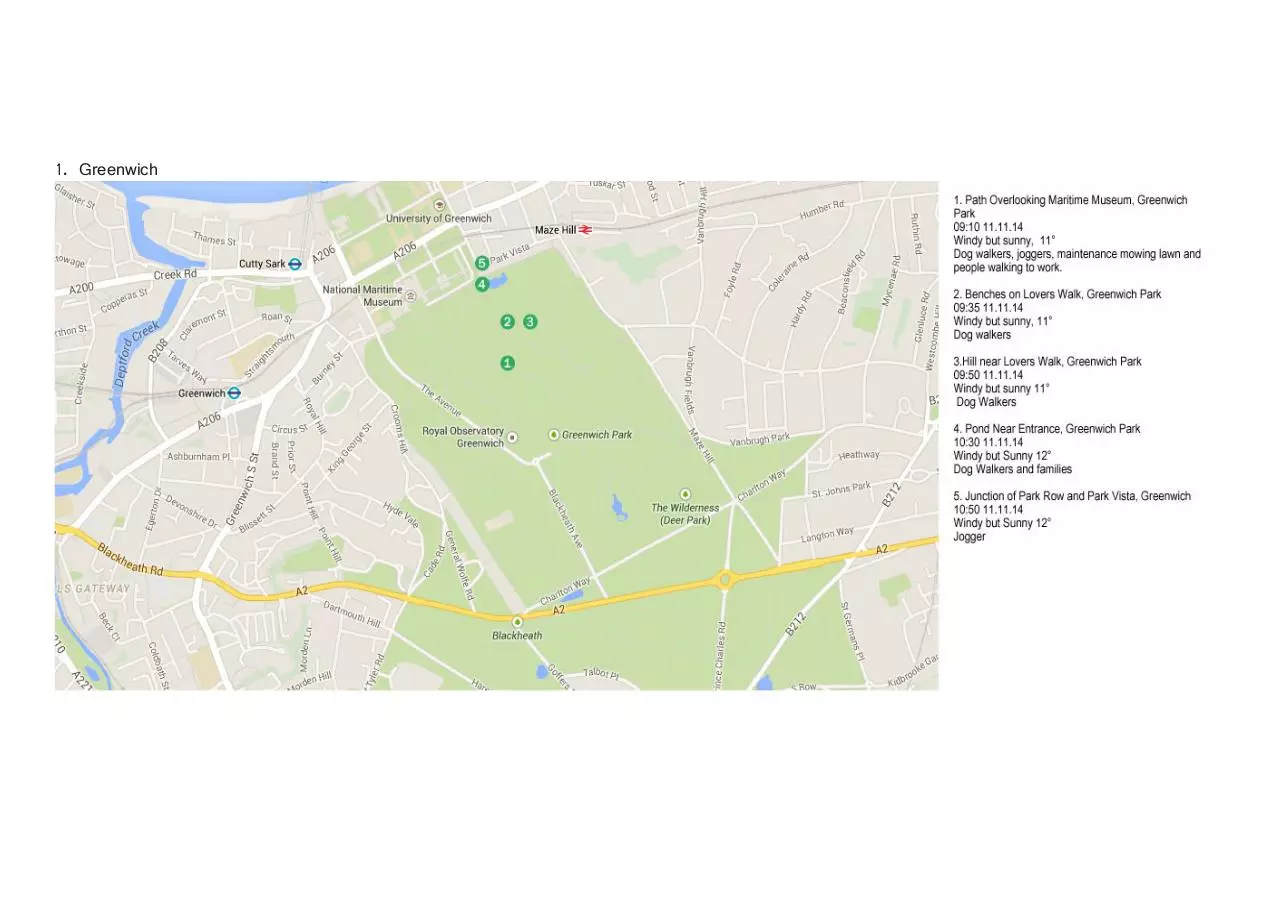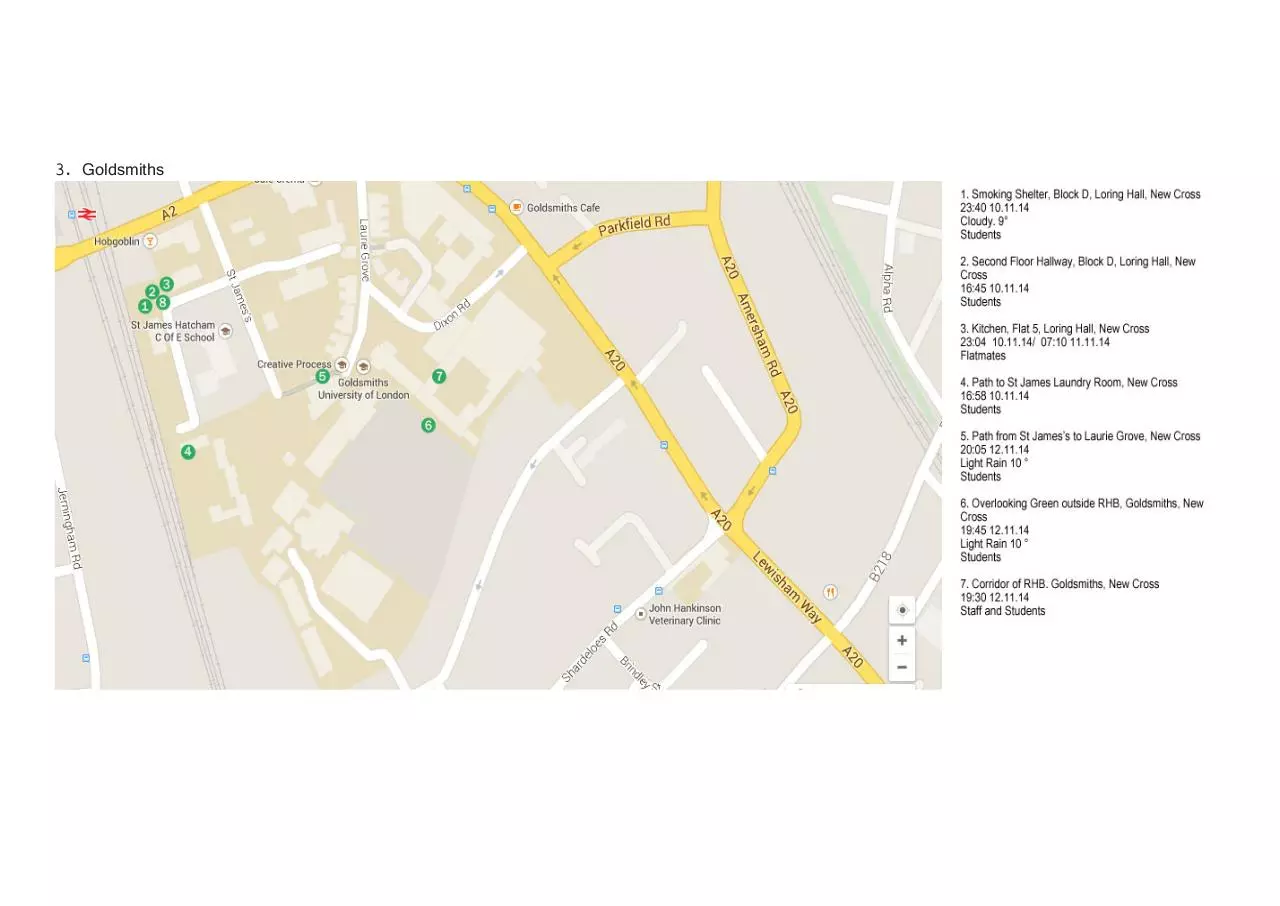BOOOOOOK (PDF)
File information
This PDF 1.3 document has been generated by Adobe InDesign CS3 (5.0) / Mac OS X 10.9.2 Quartz PDFContext, and has been sent on pdf-archive.com on 20/02/2015 at 03:40, from IP address 158.223.x.x.
The current document download page has been viewed 929 times.
File size: 4.56 MB (16 pages).
Privacy: public file





File preview
The Escape Committee
1.An Introverts Guide to London
Initial Plan;
Get a map,
Get buses to various areas of London,
Find areas where I am alone/are quiet/disused,
Begin to plot empty/quiet zones
Consider differences throughout various times of
day,
What types of areas are the quiet areas? What
kind of people are around and why?
Plot the quietest routes from A to B
Create a new map.
2. 11.11.14 - 13.11.14 Searching for quiet
in London
Starting early in the morning I began to take
buses to
various areas of London which I had researched
the night before. I filmed particularly quiet areas
and took the time and details such as weather
and who was around.
I initially focused on areas such as parks where
you would
typically go to find quiet and tranquility but as the
day
progressed and I found myself in areas such as
Waterloo where quiet is particularly hard to come
by, I began to look more at areas such as public
toilets and particularly empty bus routes.
Are there times of day where central London is
quieter?
I started to plot the locations I had found onto a map, but many of the small
side streets I had been down were hard to make out in the process so decided to
make smaller maps of each area.
1. Greenwich
2. Southwark Park
3. Goldsmiths
4. Somerset House & London Bridge
5. Richmond
Now I needed to start thinking what to do with
the information I had collected so far.
I want to make a map similar to ‘Silent London’
by
Simon Elvins, which shows quiet areas of London,
but I want to focus more on paths and routes
between quiet places.
Can I map my emotions in given areas?
PsychoGeography: “the study of the precise laws and
specific effects of the geographical environment,
consciously organized or not, on the emotions and
behavior of
individuals.”
“Unfold a street map… place a glass, rim down,
anywhere on the map, and draw round its edge.
Pick up the map, go out in the city, and walk the
circle, keeping as close as you can to the curve.
Record the experience as you go, in whatever
medium you favour.” Robert MacFarlane, Psychogeography: A Beginner’s Guide.
“A friend recently told me that he had just wandered through the Harz region of Germany while
blindly following the directions of a map of London.”
“To derive was to notice the way in which certain
areas, streets, or buildings resonate with states of
mind, inclinations, and desires, and to seek out
reasons for movement other than those for which
an environment was designed.” Sadie Plant, The
Most Radical Gesture.
Silent London by Simon Elvins (2005) “Using information the government has collected
on noise levels within London, a map has been plotted of the capitals most silent space
The map intends to reveal a hidden landscape of quiet spaces and shows an alternate
side of the city that would normally go unnoticed.”
Can I get from Southwark Park to Telegraph Hill, two
quiet places, finding a route where I see nobody?
How many times will I need to take the route to find out
when people are generally around, such as for the school
rush or walking home from uni.
Where’s quiet in New Cross?
This map is based on one trip down each individual street, for the
map to be more accurate, each route would need to be repeated a
number of times in different conditions and at various times of day.
Will this take too long?
Finding ‘pockets’ of alone. Instead of relying on parks
for quiet spaces, what about the moments you are
alone in an elevator?
Filming in elevators on Oxford Street was actually quite
difficult as although many of the elevators are off in
the corner of the shop and rarely used, it seems as
though as soon as someone sees you press the
button they run over instead of using the escalators or
stairs. (can you lead people into using the elevator?)
When editing this lot of film, as I did with my footage from around new cross, I split it into two, one
side was the ‘alone’ side and the video swapped to
the other side of the screen as soon as the doors
opened, ending that ‘pocket’ of alone.
I also experimented with filming on escalators, pointing
my phone up to the ceiling and holding it steady on
the moving hand rail, creating a smooth, slightly surreal compilation of videos.
Many of them made the shop look empty despite me
being in a crowd.
What does it really mean to be alone?
Often in cities we are surrounded by hundreds of
people but will rarely communicate of often even
awknowledge them.
Using the way I shoot my film I could create a
version of London where I’m the only person, or
at least the only one who seems to be around.
If I get up early and start filming at sunrise
which is before most shops open at 9, I should
be able to capture quiet moments in well
recognisable areas of Central London.
If I edit the sound (as I did in some earlier
experiments using footage from Oxford Street and
the sounds of Greenwich Park) I can remove
the sounds of traffic and people.
My main issue will be trying to avoid people
walking in the background of my shots, especially
if there is a long stretch of road, or on the
other side of the street.
I have plotted my initial places of interest on the
map opposite.
After the first day of filming I’ve noticed that one
major issue is handshake in the films I’ve taken.
Is there any way to prevent or lessen this?
Can I make some kind of tripod?
I made a makeshift but very convenient tripod
out of a cup with slits either side, could angle
the slits for high and low shots.
The first cup I made, while sturdy and wind resistant, cracked very easily throughout the day as
I knocked into things. Had to re-tape the cracks
shut, which meant that a number of the videos
were slightly wonky.
The second cup was far more flexible and harder
to break, it did however move around in the
wind, regardless of weighing it down, due to the
flimsy sides.
I think in future maybe I should use a real
tripod.
This is a very simplified version of my final route through London, showing my journey from its start in Camden to its end at Pontoon Dock.
Originally I wanted to begin my journey in Primrose Hill, but unfortunately due to technical difficulties the clip was lost and had to be recreated up Telegraph Hill. I was also unable to reach my chosen final location which was the Thames Barrier, as works were taking place and
the gardens were locked upon my arrival, I did still get moderately close though.
1. Camden
2. Natural History Museum
3.Royal Albert Hall
4. Hyde Park
5.
6.
7.
8.
Marble Arch
Oxford Street
Green Park
Westminster
9. Golden Jubilee Bridges
10. Southbank
11. London Bridge
12. St Pauls Cathedral
13. Barbican
114. Canada Water
15. Bow Church
16. Westferry
17. Pontoon Dock
Download BOOOOOOK
BOOOOOOK.pdf (PDF, 4.56 MB)
Download PDF
Share this file on social networks
Link to this page
Permanent link
Use the permanent link to the download page to share your document on Facebook, Twitter, LinkedIn, or directly with a contact by e-Mail, Messenger, Whatsapp, Line..
Short link
Use the short link to share your document on Twitter or by text message (SMS)
HTML Code
Copy the following HTML code to share your document on a Website or Blog
QR Code to this page

This file has been shared publicly by a user of PDF Archive.
Document ID: 0000210458.